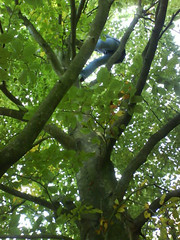 Spent Saturday and Sunday afternoons trekking up and down different bits of the Burbage valley and its environs, trampling bracken and weasling through the huge rocks. Nattered and climbed trees and braved a strange ginger cake called Parkin, and discovered we were just a short drive from the village of Eyam (pronounced “Eem”), which I’d been reading about on the train up.
Spent Saturday and Sunday afternoons trekking up and down different bits of the Burbage valley and its environs, trampling bracken and weasling through the huge rocks. Nattered and climbed trees and braved a strange ginger cake called Parkin, and discovered we were just a short drive from the village of Eyam (pronounced “Eem”), which I’d been reading about on the train up.Year of Wonders is based on the events in Eyam of 1665-6. When the first cases of bubonic plague are detected in the village, the local vicar Mompellion convinces the population not to flee. Instead of spreading the disease even further, they will wait it out. Those who agree to this are slowly picked off by the horrific symptoms – two thirds of them are to die. But for Anna Frith, young widow and household help to Mompellion, this terrible suffering and loss will also transform her life…
It’s a gripping page-turner, and Geraldine Brooks is good at supplying enough detail that readers can follow the development and spread of the disease through flea-infested clothing, while the characters never quite make that same connection. Like watching Casualty, we’re glued to finding out which of the characters we’ve just met are to meet grisly ends. Like Casualty, for all there’s a moral dimension to the suffering and social breakdown, there’s also a horrid randomness to the infection and death, which spares neither good nor innocents.
As well as the plague, there’s witch-hunts and the perils of lead-mining, as well as a gravedigger who starts burying those as yet not dead. This packing-in of incident can make the book feel overly contrived at times. And for all Brooks draws strong and memorable characters, and deftly convinces us of the intrigues and scandals of a small community, the cowardly toffs who flee for their lives are too obvious and uncomplicated villains.
Also felt the final section, after the plague, a little too extraordinary, with sudden revelations and reversals that didn’t really fit the cosy, claustrophobic catastrophe of the main part. “This book is a work of fiction inspired by the true story,” begins the author’s afterword, and I felt the novel maybe changed too much of the wondrous-enough reality to fit the convenience and structure of its plot. It’s an absorbing and well-constructed read, but less successful the more it is not true.
 We visited the Church of St Lawrence, whose plague display inspired the novel, and passed the cottages that tell you which families lived in them and how many of them died. We poked our fingers into the round holes of the boundary stone, once filled with coin to pay for food from those beyond the quarantine line, the holes filled with vinegar to kill the plague seed that might be attached to the coin.
We visited the Church of St Lawrence, whose plague display inspired the novel, and passed the cottages that tell you which families lived in them and how many of them died. We poked our fingers into the round holes of the boundary stone, once filled with coin to pay for food from those beyond the quarantine line, the holes filled with vinegar to kill the plague seed that might be attached to the coin.Home on the 2.27 today, passing the wonky, twisty spire at Chesterfield on the way back to the nearly-done space-age refit of St Pancras Station. Having swapped a plethora of top facts with cousin A. all weekend, was pleased to hear a fellow passenger explain to their spawn how Queen Boudicca and her Iceni pals had bitch-slapped the Romans right where we was shlepping.








No comments:
Post a Comment